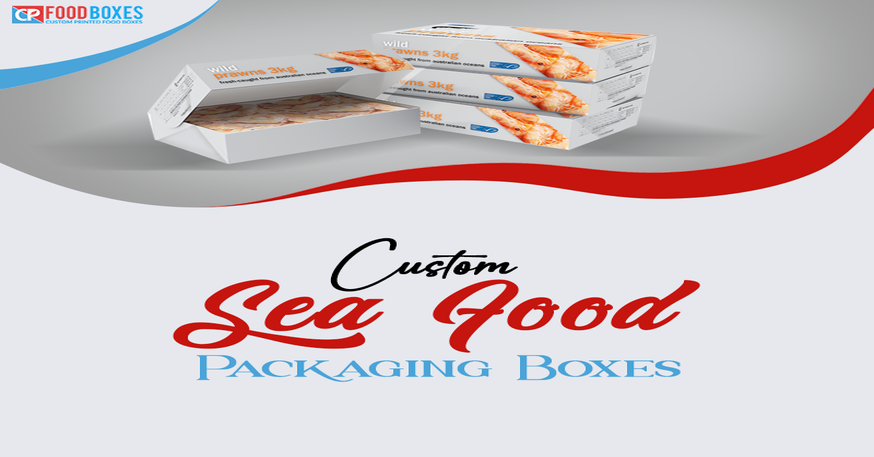
The packaging of seafood continues to evolve, just like any other type of food. When you browse through the shopping shelf on the market, you are likely to find flexible, presentable, and attractive seafood shipping boxes that stick in your mind. Custom seafood Packaging boxes display the charm of your product with its sleek and modern layout.
Let’s look at some of the perks of having custom seafood packaging and how it appeals to end-users.
It has always been important to make the most economic use of storage space and with more frozen food options being available all the time, running out of space can be a very quick occurrence. There are often limitations to the amount of space you can find for your frozen food, especially in smaller freezers.
Custom seafood boxes present a perfect solution to this problem. The ease of customizing seafood packaging allows for better use of freezer space by reducing the need to remove or rearrange items.
This can present a challenge for custom seafood suppliers. They have to make boxes that will sit well with the dimensions of the product. Because many of the custom packagings occupy unnecessary space the packaging was not made considering the structure of the product.
Adaptable packaging provides the requisite flexibility to the product contained inside. Which keeps fish, clams, lobsters, and other seafood in pristine condition, Because seafood packaging can take care of all their shapes and sizes.
When it comes to quality, adaptable seafood packaging is a better choice for sealing food and preserving it. Despite the ability to close more traditional packaging systems. whether in a freezer, refrigerator, or cabinet – these cannot maintain product integrity. Even after sealing up the box and keeping the food inside the box, the food will eventually lose freshness.
For this purpose, wax-coated seafood boxes are perfect. They can ensure longevity, even when the product stays in the packaging for a long time. But there is another thing: no matter how delicious the seafood is. It tends to lose the overwhelming smell that will often make people uncomfortable. Therefore, sealable wax boxes for seafood keep the scent and flavor of the product, preventing it to lose the taste.
The design options for flexible seafood packaging are also beneficial if you are a seafood supplier. The right packaging, one that’s convenient, and one that’s long-lasting can help improve sales and gain customer loyalty. Such custom seafood packaging boxes not only impress the consumers on the retail shelf but can also bring more loyalty and credibility to your brand.
Your business is likely to get more repeat business because people want an unforgettable experience so that they can associate with your business. This is a powerful way to get more customer loyalty and increase brand awareness.
Seafood shipping boxes that have your company logos engraved on them provide a more unique touch for your product. Apart from differentiating your custom seafood packaging boxes from other peers in the market, it gives identity to your merchandise. This makes people remember your product even if a significant time has passed.
After exploring the significance of seafood packaging now it’s time to discuss some of the seafood packaging types that are famous in the packaging industry. Many retailer seafood suppliers are concerned and looking for the best-customized solutions for their products like clams, salmon, lobster, and so on.
Fret not, here you will find some of the packaging types and techniques that are top-notch and emphasize preserving the taste of seafood products.
The seafood industry has long relied on the practice of canning. The processing process results in many types of seafood, such as lobster, whitefish, salmon, crab, anchovies, sardines, and a lot of other kinds of aquatic edibles are preserved using canning.
Canning involves putting the seafood inside the can, then it is sealed with a metallic list then reheated to stop air from entering. As a result, the food inside of the can is preserved. It enables you to store seafood for quite a long time.
One drawback of canning is that it leaves carbon footprints on our environment. Therefore, this method has many critics.
Bags that can be repurposed or used again are referred to as flexible pouches. Plastic, metal, and cardboard are the most frequently used materials for flexible pouches.
They are also used in the packaging of industrial beverages and consumer goods like snacks, caffeine, cereal, industrial liquids, and powders.
Due to their eco-friendly and green features, they are trending in the market. Another good thing about these pouches is they are resealable.
Skin packaging, commonly used for packaging seafood such as fish fillets, is a combination of layered packaging components. With skin packs, a slim film of translucent plastic is placed on seafood products and then backed with paperboard.
According to your unique business application, product, budget. and demand you should always consider the option of purchasing wholesale seafood boxes. It provides you an opportunity to negotiate the price for bulk purchases and you end up saving more than you anticipated.
